Webinar Implementation of the Self-cleaning Technology in Evaporators
Written by Klaren International on November 4, 2020.
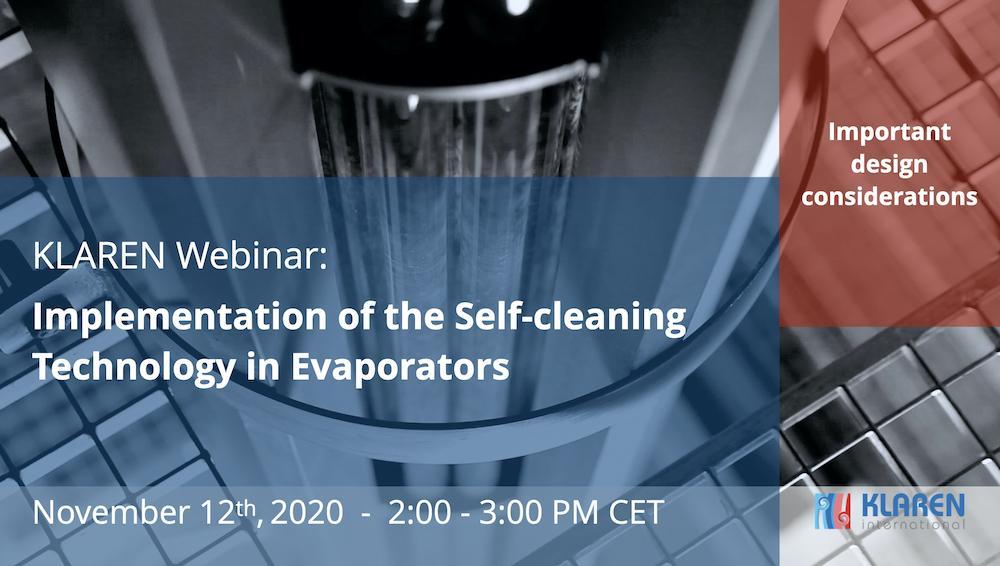
Important Design Considerations
The self-cleaning fluidized bed heat exchanger technology has been successfully applied in Multi-Effect Evaporators and will be applied in MVR Evaporators as well. The technology has proven to be able to eliminate (severe) fouling in evaporators and ensures constant evaporation capacity and longer operational time.
In this webinar Marco van Beek, CTO of Klaren International, will explain how the self-cleaning technology can be implemented in MEE (single effect/multi-effect/TVR) as well as MVR.
The following topics will be addressed:
- Introduction Self-cleaning Heat Exchanger Technology
- References Evaporators
- Different Evaporator Systems
- Maximum Concentration / Boiling Point Elevation (BPE)
- MEE; Design Aspects
- MVR; Design Aspects
If you are interested to join our webinar on 12 November 2020 from 2-3 PM CET, please click on the button to register.
Webinar Self-cleaning Heat Exchanger Technology
Written by Klaren International on October 14, 2020.
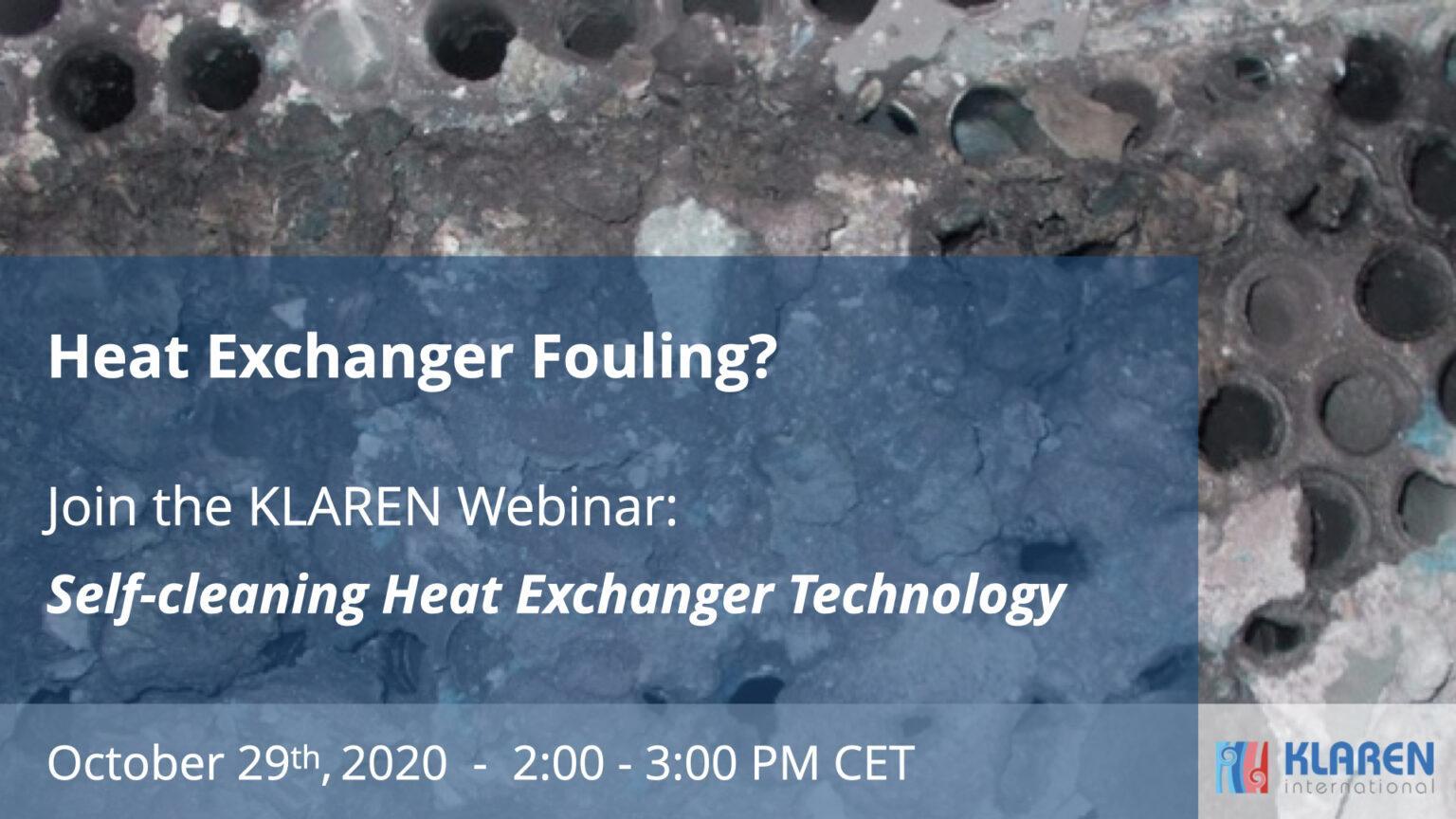
Are you dealing with heat exchanger fouling? A self-cleaning fluidized bed heat exchanger can be the solution!
In our webinar on Thursday 29 October 2020 from 2-3 PM CET, Marco van Beek, CTO of Klaren International, will explain the self-cleaning fluidized bed technology and how the technology is used to keep the heat exchangers clean and heat transfer constant.
Self-cleaning Evaporator driven by MVR, the way to go!
Written by Klaren International on April 28, 2020.

Self-cleaning heat exchangers have been applied for decades and have proven to solve cases where fouling of the tubes caused severe problems. For the past 2 years Klaren International is active in India together with Shachi Engineering to supply Multi-Effect Evaporator (MEE) plants to treat difficult effluent from manufacturers of dye-stuff. In these plants one of the effects is equipped with the self-cleaning configuration while the other effects are of the conventional forced circulation type.
The reason to equip only one of the effects with the self-cleaning configuration is purely economic. The self- cleaning technology will require additional CAPEX but will give a higher availability and productivity of the plant and avoid cleaning costs. So, selecting the effect most prone to fouling can already make a huge step to increase the time between cleanings but it means that the other effects still can show fouling. This is one of the important reasons why a concept using Mechanical Vapour Recompression (MVR) is very interesting because there will only be one effect. So, the question about which effect to equip with the self-cleaning technology becomes obsolete.
In an evaporator driven by an MVR (or MVC which are synonyms), the vapour coming from the evaporation is compressed by a compressor to a higher pressure and temperature. This higher temperature allows the vapour to be used at the shell side of the heat exchanger in the evaporator where it condenses. In other words, all the energy used to evaporate or the latent heat is recovered. In a MEE this by definition is only done partially. Of course, the MVR requires energy to drive the compressor but overall the use of primary energy is significantly less.
The white paper “Self-cleaning evaporator driven by MVR, the way to go!” discusses the MVR with the self- cleaning system from different perspectives, its energy consumption, the experiences with self-cleaning, the design of it and the operational aspect of applying a compressor.
Self-cleaning Heat Exchanger for heating a Zinc Phosphate Solution
Written by Klaren International on April 27, 2020.

Together with our partner Sistemas in Turkey (Izmir), a self-cleaning heat exchanger was successfully installed at a plant of a large manufacturer and supplier of iron and steel (products) in the Kocaeli Province in Turkey. The self-cleaning heat exchanger is used to keep the temperature of a zinc phosphate bath constant in which steel components are treated with a zinc phosphate coating. The self-cleaning heat exchanger, made of stainless steel, operates with ceramic cleaning particles of 3 mm to prevent fouling of the heat exchanger tubes. Since the installation, the self-cleaning configuration has kept the heat exchanger tubes clean.
Successful Commissioning of a Self-cleaning Evaporator
Written by Klaren International on June 25, 2019.
Another successful commissioning of a self-cleaning fluidized bed heat exchanger – the KLAREN system – in a waste water evaporation plant.

The heat exchanger converted to the KLAREN system is the 1st stage of a 4-effect evaporator train to treat waste water from a plant producing dyes for textiles. The heat exchanger earlier experienced severe fouling by salts of calcium, magnesium and silica.Due to fouling the evaporation capacity of the plant reduced to 50% in 20 days and the plant required cleaning of tubes. Subsequent to the commissioning with Klaren system the plant is operating at design evaporation capacity under stable conditions of the fluidized bed. With the KLAREN system, we make evaporator plants more sustainable.
Business Benefit Self-Cleaning Heat Exchanger
Written by Klaren International on March 12, 2019.
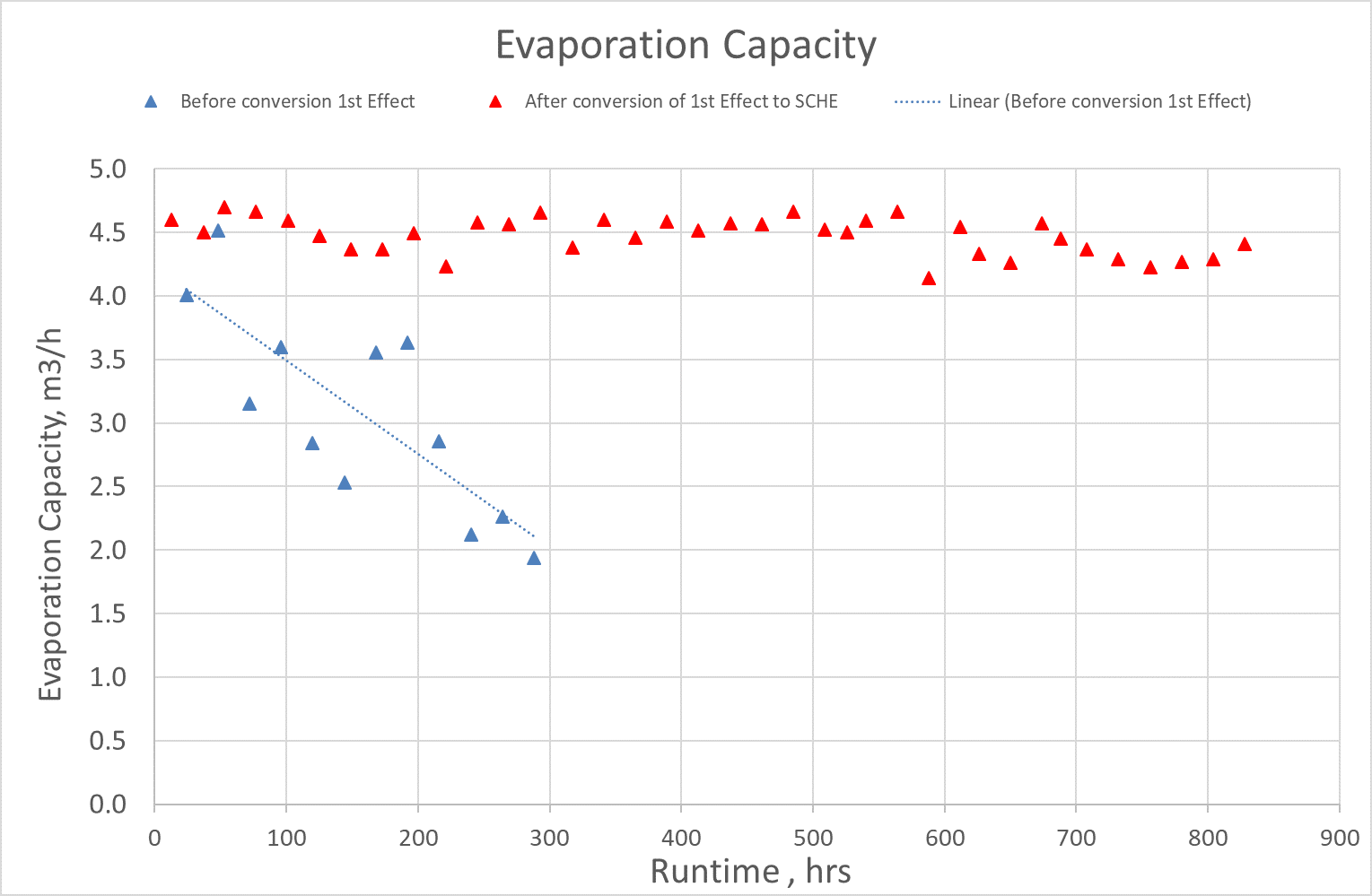
After the first period of operation we can answer this question. The answer comes from the graph that is added to this post. Previous experience of the plant showed that because of fouling of the heat exchanger tubes, the evaporation capacity of the plant reduced with 50% within 12 days of operation. After the retrofit to our technology, using a fluidized bed with cleaning particles, the evaporation capacity remained constant.Before the conversion the average production capacity was only 75% of design. So, with our technology the client has gained 33% production capacity. The benefit would be even greater in case the production loss due to the down-time for cleaning (can take between 2 and 5 days) would be considered as well.When comparing the investment for adding 33% capacity using conventional technology with the investment for a retrofit into the self-cleaning heat exchanger, a decision can be easily made. The investment for a retrofit is a factor of 3 smaller.
Self-cleaning Evaporator Pilot Unit for the Concentration of Digestate
Written by Klaren International on December 7, 2018.
We have successfully operated our self-cleaning evaporator pilot unit for treating digestate from a biogas plant in Germany. The aim was reducing the volume of the Digestate without facing fouling problems and maintaining high heat transfer coefficients with this viscous fluid.
Next year the pilot unit will become available for other evaporation cases.
Order for 3 Evaporator Plants
Written by Klaren International on October 25, 2018.
Shachi Engineering Pvt. Ltd. (Pune), our partner in India, has been granted the order for 3 new waste water treatment plants for the dye-making industry. The plants apply multi-stage evaporation of which the first and second stage will be configured with the self-cleaning technology of Klaren International. The design of the plant has been optimized for steam efficiency and to have a compact design. The order was granted after a successful project in which one of the existing evaporators of this client was revamped into the self-cleaning system and showed constant evaporation where previously fouling was an important issue.
Fluidized bed technology for carbon capture process
Written by Klaren International on December 6, 2017.

Klaren International has worked together with Sustainable Energy Solutions (SES) to experimentally test the use of the fluidized bed heat exchanger technology as a part of SES’ innovative Cryogenic Carbon Capture process.
SES develops innovative solutions to sustainability problems within the energy industry. Their Cryogenic Carbon Capture™ (CCC) technology eliminates most emissions from fossil fuels. This CCC technology is projected to cost half as much as alternatives.
Fouling Conference 2017, Madrid
Written by Klaren International on June 21, 2017.
In the week of June 12th to June 16th the 2017 Fouling Conference was held in Madrid. At the fouling conference, it was again confirmed that fouling is a big problem in industry. Both researchers and industry are working on methods to mitigate it. Marco van Beek, CTO of Klaren International, presented two papers with applications based on the self-cleaning fluidized bed heat exchanger technology:
- Fluidized bed heat exchangers for the evaporation of waste waters: design advantages and operational experiences
- Horizontal shell side fluidized bed heat exchanger, design considerations and experiences from a pilot unit
The papers will be officially published after peer review by the technical committee Heat Exchanger and Fouling Conference 2017.
Produced Water Concentration by Fluidized Bed Evaporators
Written by Klaren International on June 17, 2017.
Produced water is a by-product of oil and gas extraction. Regulations for fresh water recovery from these waters are becoming stricter, which makes operating costs for disposal expensive. Therefore, oil companies are paying more attention to systems to treat this water in an economically efficient way. A combination of forced circulation or falling film evaporation with mechanical vapor recompression (MVR) is a commonly used configuration. Vapor out of one stage evaporator is compressed and used as heat input in the shell side of the evaporator. The condensate can be re-used while the discharge can be further concentrated in crystallizers, dryers or just disposed in solar ponds for further evaporation. In some cases, the remaining liquid discharge is re-injected in wells.Highly mineralized water is evaporated at high temperatures in the process to treat produced water. The combination of high mineral concentration and high temperatures causes these water solutions to precipitate minerals which crystallize as a scaling layer on the walls of the heat exchangers of the evaporators. Fouling of heat exchangers in this application results in:
- Production losses or reduced operation capacity
- Over sizing and / or redundancy of equipment
- Increase in maintenance costs
- Disposal of waste streams from using cleaning chemicals
A common practice to reduce the fouling effects in produced water evaporation is to use expensive softening pre-treatment plants and to limit the mineral concentration levels due to the relation between mineral concentration and fouling tendency. This adds a constrain into the maximum produced water volume reduction that can be achieved through evaporation.To avoid problems associated with fouling and to be able to further concentrate produced water above typical concentration levels, fluidized bed heat exchangers can be used. Fluidized bed heat exchangers can be used as forced circulation evaporators by combining a regular fluidized bed heat exchanger and a flash vessel downstream the liquid outlet. And can be integrated not only in MVR configurations but also in thermo-compressor or multiple effect evaporator trains.
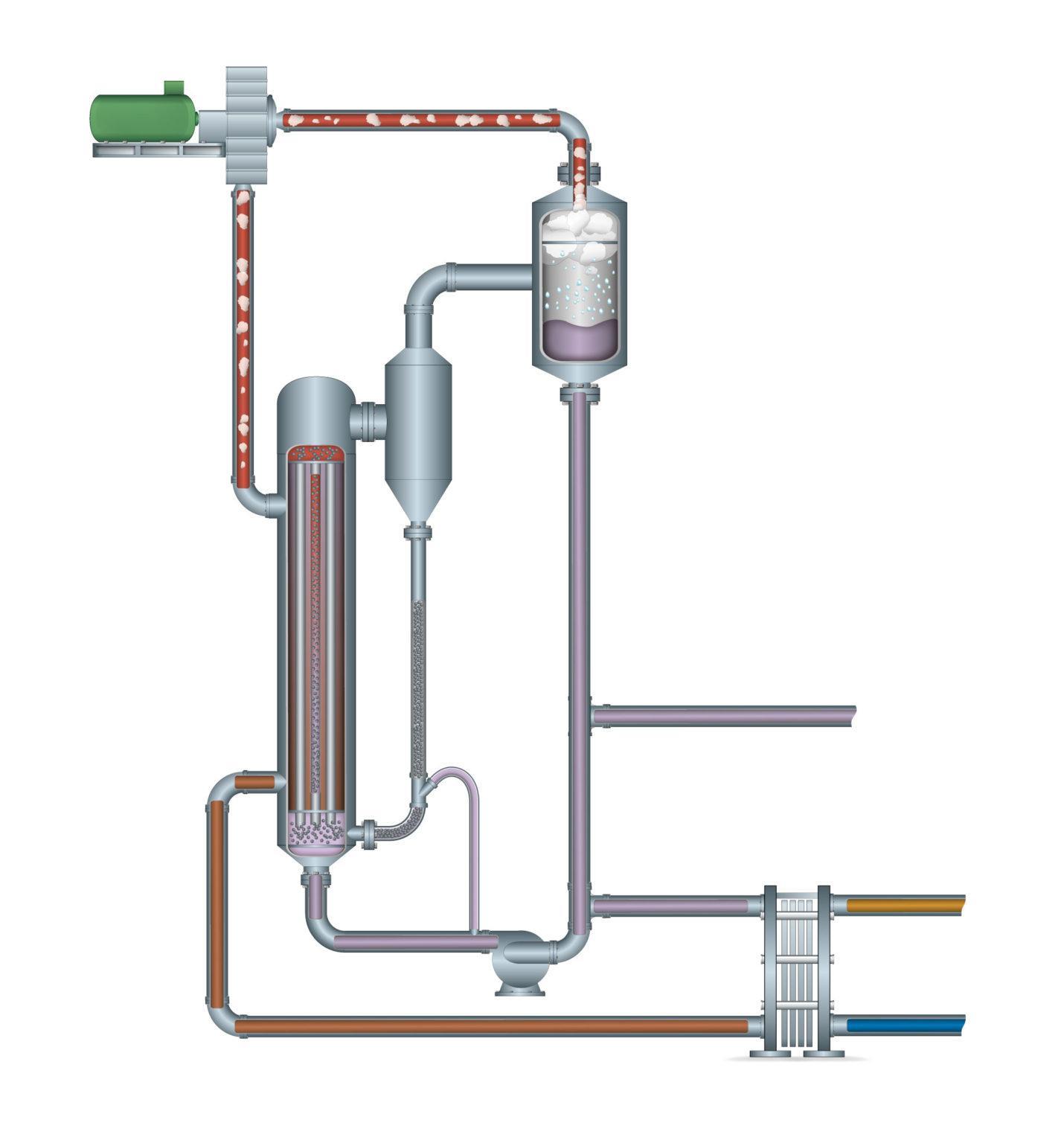
The capital cost of evaporation systems including fluidized bed heat exchangers is lower than of conventional forced circulation or falling film systems. This is because there is no need for expensive softening systems prior to evaporation and redundancy is not required. When a downstream Zero Liquid Discharge (ZLD) stage (crystallizer or dryer) is installed, the capital cost difference is larger. If a fluidized bed heat exchanger is used it can lower size requirements of these systems. Operating costs are also lower due to lower costs of treatment or disposal of the evaporator discharge.More details on this topic have been presented at the Heat Exchanger Fouling and Cleaning XII – 2017 conference in Madrid, Spain, on June 11-16, 2017. A full detailed paper is available.
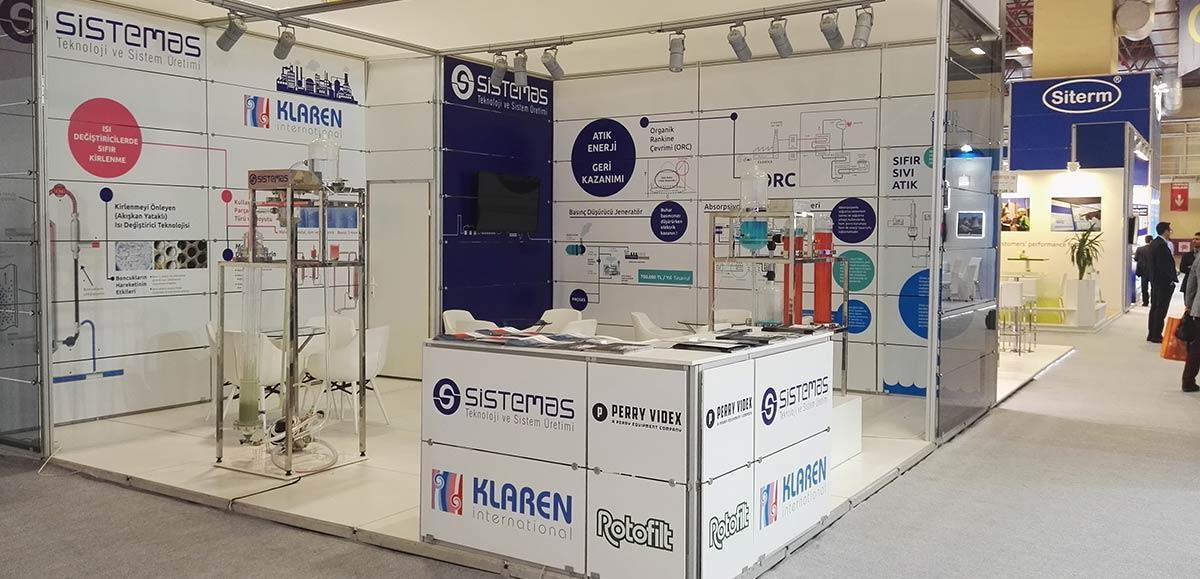
Klaren International attends the ICCI 2017 | 23rd International Energy & Environment Fair & Conference in Istanbul (Turkey)
Written by Klaren International on May 3, 2017.
From 3-5 May 2017 we attend together with our Turkish business partner Sistemas the ICCI 2017 | 23rd International Energy & Environment Fair & Conference in the Istanbul Expo Center (Turkey). We have a demo unit in the booth to show and explain the working principle of the self-cleaning heat exchanger technology. Please visit us. You can find us at booth D108.
Klaren International and Bronswerk Heat Transfer sign Cooperation Agreement
Written by Klaren International on March 15, 2017.
Klaren International and Bronswerk Heat Transfer, both based in the Netherlands, have signed a cooperation agreement aimed at selling, designing and worldwide delivery of heat exchangers based on the self-cleaning heat exchanger technology of Klaren International.
Klaren International is specialized in designing and realizing self-cleaning heat exchangers. The mission of Bronswerk Heat Transfer is to offer the client the best solutions for heat transfer and fluid-flow systems, optimized for thermodynamical, mechanical and economical aspects and realizing the greatest possible benefits. The challenges presented by the client are translated in sustainable, energy saving and innovative solutions of the highest possible quality.
With the self-cleaning heat exchanger technology, we can design heat exchangers for zero fouling operation. In the self-cleaning heat exchangers, a fluidized bed of solid particles is used at the tube side where the fouling liquid flows through. The solid particles create a scouring effect on the tube wall surface which removes the developing fouling layer. In this way, severe fouling of shell and tube heat exchangers is prevented. Either new or revamped heat exchanger solutions with a zero-fouling configuration can be realized in many types of industries.
Single Tube Test Unit sold to Sabic (India)
Written by Klaren International on January 31, 2017
Klaren International has sold a single tube heat exchanger test unit to SABIC, India, a Saudi diversified manufacturing company. This test unit is first of its kind and has been designed to fit in the testing facility of SABIC in Bangalore, India.
With this single tube heat exchanger unit, SABIC can test multiple process applications and study the performance of the self-cleaning heat exchanger technology for their fouling applications. The test unit is currently being installed at the testing facility in Bangalore and commissioning, followed by initial testing, is expected to begin in mid-April 2017. With this project, a collaboration with SABIC started.
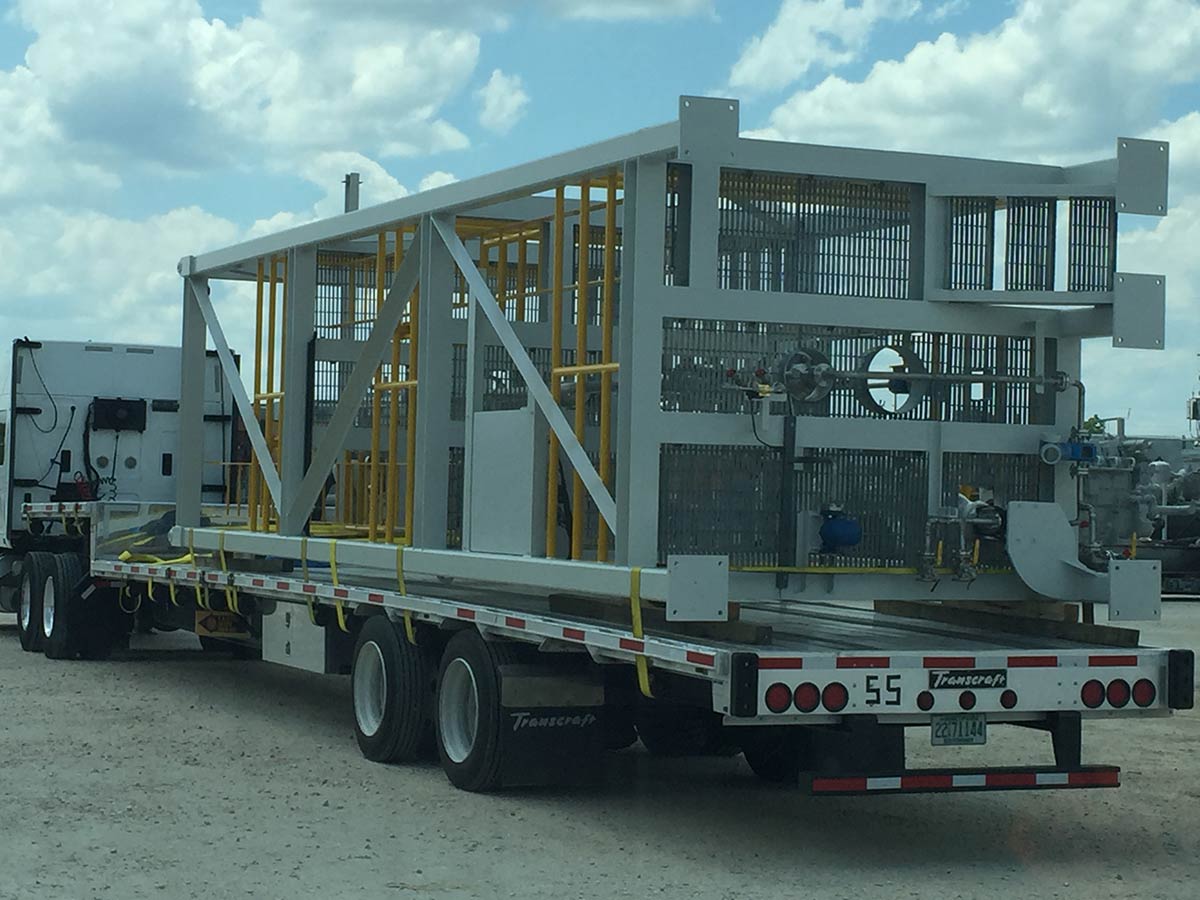
Single Tube Test Unit sold to mining company in the USA
Written by Klaren International on June 8, 2016.
 Our newly developed single tube test unit, based on the self-cleaning heat exchanger technology, with skid has been sold to a mining company in the USA for testing the self-cleaning performance of the heat exchanger.
Our newly developed single tube test unit, based on the self-cleaning heat exchanger technology, with skid has been sold to a mining company in the USA for testing the self-cleaning performance of the heat exchanger.
Every client process is unique and therefore a pilot test is required to determine the overall heat transfer coefficient and to demonstrate the self-cleaning performance. In the past, such a pilot represented a section of the planned full-size heat exchanger applying the same temperatures and ΔTlog. These pilots were equipped with a minimum of 7 tubes of same tube diameter and length, as planned for the full-size heat exchanger. To reduce the costs of a pilot test we have developed a test unit that consists of a shell and tube heat exchanger with only one single tube and a particle separation and recirculation down-comer tube.
In the single tube test unit liquid flow, particle flow, porosity of the fluidized bed in the heat exchange tube, type of particles and particle size can be varied independently. The heat transfer performance, i.e. k-value, can be measured with the instrumentation, and optimized as a function of all relevant parameters.

